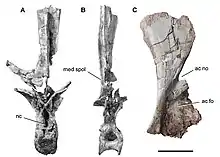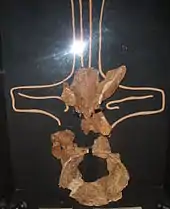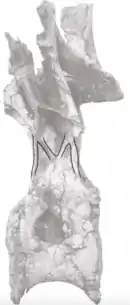Rebbachisaurus
Rebbachisaurus (meaning "Aït Rebbach lizard") is a genus of sauropod dinosaur of the superfamily Diplodocoidea, that lived during the Late Cretaceous period in Africa about 99-97 million years ago. Remains attributed to Rebbachisaurus have been found in Morocco, Niger, Algeria and Tunisia, although only the Moroccan remains can be referred to the genus without doubt. The discovery of Rayososaurus, a South American sauropod nearly identical to Rebbachisaurus, supports the theory that there was still a land connection between Africa and South America during the Early Cretaceous, long after it was commonly thought the two continents had separated.[1]
| Rebbachisaurus | |
|---|---|
 | |
| Holotype dorsal vertebra (A, B) and scapula (C) | |
| Scientific classification | |
| Kingdom: | Animalia |
| Phylum: | Chordata |
| Clade: | Dinosauria |
| Clade: | Saurischia |
| Suborder: | †Sauropodomorpha |
| Clade: | †Sauropoda |
| Clade: | †Eusauropoda |
| Clade: | †Neosauropoda |
| Family: | †Rebbachisauridae |
| Genus: | †Rebbachisaurus Lavocat, 1954 |
| Species: | †R. garasbae |
| Binomial name | |
| †Rebbachisaurus garasbae Lavocat, 1954 | |
| Synonyms | |
| |
History of discovery


In 1954, Rene Lavocat discovered the holotype specimen of Rebbachisaurus, which consists of ten ribs, the right shoulder blade, eleven vertebrae, the sacrum, a humerus, and two bones probably belonging to the pelvis, in the Aoufous Formation at Gara Sba, Errachidia in Morocco. He named the type species R. garasbae during the same year but only the shoulder blade and a single vertebra from the string of eleven were initially described, very briefly and without illustrations.[2] The fossils were left undescribed and neglected until 2015, when Jeffrey Wilson and Ronan Allain cleaned the holotype and described the remaining fossils that Lavocat never described in 1954.[3] A second specimen, consisting of a partial vertebra measuring up to 1.45 metres (4.8 ft) tall if complete (also found in Aoufous) has also been assigned to R. garasbae.
A second species was named by de Lapparent in 1960, Rebbachisaurus tamesnensis. The type specimen, collected by Lapparent in the Gall locality, Irhazer Shale, supposedly composed of two humeri and two femora, and a second specimen composed of four isolated teeth, a dentary fragment with three teeth, over 100 vertebrae, six chevrons, 12 ribs, 5 scapulae, an ilium, two ischia, and numerous limb elements, but however, the material of this taxon was collected from multiple localities across the Sahara, such as several sites in the Elrhaz Formation of Niger, and is not referrable to Rebbachisaurus.[4] R. tamesnensis was probably a synonym or a chimera of Nigersaurus taqueti,[5][6] although some authors (such as Paul Sereno) consider R. tamesnensis to be a synonym of Jobaria, the only known valid sauropod from Tiouraren.[7][8]
A third species was named by Calvo and Salgado in 1995, Rebbachisaurus tessonei.[9] It was discovered in the Candeleros Formation in Argentina, near to where the holotype of Giganotosaurus carolinii was discovered. This species was later moved to the new genus Limaysaurus in 2004.[10]
Description

In 2010, Gregory S. Paul estimated Rebbachisaurus at 14 metres (46 ft) and 7 metric tons (7.7 short tons).[11] Holtz gave a bigger length of 20 metres (66 ft).[12] In 2020 Molina-Pérez and Larramendi gave a larger estimation of 26 meters (85.3 ft) and 40 tonnes (44 short tons).[13] It possessed a small head, a long, graceful neck and a whiplike tail. Rebbachisaurus is distinguished from other sauropods by its unusually tall, ridged back and the spine or sail that lay atop its back, distinguished by the tall ridges of the preserved dorsal vertebrae of the holotype and other specimens.[14]
Classification
Below is a cladogram following the 2013 analysis by Fanti and colleagues, which confirmed the placement of Rebbachisaurus as a basal rebbachisaurid.[15]
| Rebbachisauridae |
| ||||||||||||||||||||||||||||||||||||||||||||||||||||||
A 2015 cladistic study by Wilsona and the French palaeontologist Ronan Allain found Rebbachisaurus itself to group with the nigersaurines, and the authors suggested that Nigersaurinae was therefore a junior synonym of Rebbachisaurinae (since that name would have priority).[16]
Paleoecology
The most common vertebrate remains which coexisted alongside R. garasbae in the Aoufous belong to the elasmobranch fish Onchopristis numidus. Another seven elasmobranchs are reported: Asteracanthus aegyptiacus, Distobatus nutiae, Tribodus sp., Lissodus sp., Haimirichia amonensis, Cretoxyrhinidae indet., and Marckgrafia lybica. Lungfish fossils are referred to Ceratodus humei and Neoceratodus africanus. Coelacanth remains are referred to Mawsonia lavocati and to the genus Axelrodichthys. Several taxa of Cladistia and two genera of seminiomorphs (an unnamed Lepidotes-like species and Oniichthys falipoui) are recovered in the Kem Kem beds. Teleosteans are represented by Cladocyclus pankowskii, Palaeonotopterus greenwoodi, Erfoudichthys rosae and Concavotectum moroccensis. Amphibians are also present: Kababisha sp., the pipid frog Oumtkoutia anae and non-pipids frogs. Turtles are represented by several species: Dirqadim schaefferi, the podocnemidids Hamadachelys escuilliei, the bothremydids Galianemys whitei and G. emringeri, and the araripemydids Araripemys sp. Crocodilians are commonly found; four species are present: Elosuchus cherifiensis, a genus belonged to the Trematochampsidae, Araripesuchus rattoides and Laganosuchus maghrebensis.
Rebbachisaurus garasbae coexisted with many dinosaurs, including an ornithischian and an unnamed basal theropod, both only known from footprints.[17] Among theropods, two carcharodontosaurids (Carcharodontosaurus saharicus and Sauroniops pachytholus), one spinosaurid (Spinosaurus aegyptiacus), one coelurosaur (Deltadromeus agilis), an unnamed abelisaur and an unnamed dromaeosaur also coexist with Rebbachisaurus.[17]
Pterosaurs are also present, although their fossils are extremely rare and enigmatic: an azhdarchid, an ornithocheirid, a tapejarid and a pteranodontid are known to have coexisted with Rebbachisaurus.[17]
References
- Bonaparte, J. (1996). "Cretaceous tetrapods of Argentina". Münchner Geowissenschaften Abhandlungen 30: 73-130.
- Lavocat R (1954) "Sur les dinosauriens du Continental Intercalaire des Kem-Kem de la Daoura" (On the dinosaurs from the Continental Intercalaire of the Kem Kem of the Doura). Comptes Rendus 19th International Geological Congress, 1952, 1: 65-68.
- Wilson, Jeffrey A.; Allain, Ronan (2015-06-23). "Osteology of Rebbachisaurus garasbae (Lavocat, 1954), a diplodocoid (Dinosauria, Sauropoda) from the early Late Cretaceous–aged Kem Kem beds of southeastern Morocco". Journal of Vertebrate Paleontology. 35 (4): e1000701. doi:10.1080/02724634.2014.1000701. ISSN 0272-4634. S2CID 129846042.
- de Lapparent A. F. (1960) "The dinosaurs of the “Continental Intercalaire” of the central Sahara". Memoirs of the Geological Society of France - Vol. 39 - 1-6.
- Upchurch, P., Barrett, P.M., and Dodson, P. (2004). "Sauropoda". In D. B. Weishampel, H. Osmolska, and P. Dodson (eds.), The Dinosauria (2nd edition). University of California Press, Berkeley 259–322.
- Mannion PD., Barrett PM. 2013. Additions to the sauropod dinosaur fauna of the Cenomanian (early Late Cretaceous) Kem Kem beds of Morocco: Palaeobiogeographical implications of the mid-Cretaceous African sauropod fossil record. Cretaceous Research 45:49–59.
- Sereno PC. 1999. Cretaceous Sauropods from the Sahara and the Uneven Rate of Skeletal Evolution Among Dinosaurs. Science 286:1342–1347.
- Sereno PC., Wilson J a., Larsson HC., Dutheil DB., Sues HD. 1994. Early cretaceous dinosaurs from the sahara. Science 266:267–271.
- Calvo G. O. and Salgado L (1995) "Rebbachisaurus tessonei sp. nov. A new sauropod from the Albian-Cenomanian of Argentina; new evidence on the origin of the Diplodocidae". GAlA No 11, pp. 13-33.
- Salgado, L., Garrido, A., Cocca, S. E., and Cocca, J. R. (2004). "Lower Cretaceous rebbachisaurid sauropods from Cerro Aguada Del León, Neuquén Province, northwestern Patagonia, Argentina." Journal of Vertebrate Paleontology, 24(4): 903-912, December 2004.
- Paul, G.S., 2010, The Princeton Field Guide to Dinosaurs, Princeton University Press p. 186
- Holtz, Thomas R. Jr. (2011) Dinosaurs: The Most Complete, Up-to-Date Encyclopedia for Dinosaur Lovers of All Ages, Winter 2010 Appendix.
- Molina-Pérez & Larramendi (2020). Dinosaur Facts and Figures: The Sauropods and Other Sauropodomorphs. New Jersey: Princeton University Press. p. 255.
- Apesteguía S, Gallina PA and Haluza A (2010) "Not just a pretty face: anatomical peculiarities in the postcranium of Rebbachisaurids (Sauropoda: Diplodocoidea)". Historical Biology, Volume 22, Issue 1-3: Proceedings of the First International Congress on North African Vertebrate Palaeontology.
- Fanti, F.; Cau, A.; Hassine, M.; Contessi, M. (2013). "A new sauropod dinosaur from the Early Cretaceous of Tunisia with extreme avian-like pneumatization". Nature Communications. 4: 2080. Bibcode:2013NatCo...4.2080F. doi:10.1038/ncomms3080. PMID 23836048.
- Wilson, J. A.; Allain, R. (2015). "Osteology of Rebbachisaurus garasbae Lavocat, 1954, a diplodocoid (Dinosauria, Sauropoda) from the early Late Cretaceous–aged Kem Kem beds of southeastern Morocco". Journal of Vertebrate Paleontology. 35 (4): e1000701. doi:10.1080/02724634.2014.1000701. S2CID 129846042.
- L. Cavin, H. Tong, L. Boudad, C. Meister, A. Piuz, J. Tabouelle, M. Aarab, R. Amiot, E. Buffetaut, G. Dyke, S. Hua and J. Le Loeuff. 2010. Vertebrate assemblages from the early Late Cretaceous of southeastern Morocco: An overview. Journal of African Earth Sciences 57:391-412












